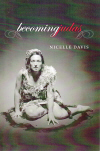Becoming Judas
Becoming Judas, Nicelle Davis’s second full-length poetry collection, is a strange, beautiful, complicated book which includes equally strange and beautiful illustrations by artist Cheryl Gross. The book is comprised of a vast cast of voices and stories, with the speaker weaving religious history, popular culture, and personal experience into a complex personal mythology. Judas and Jesus may be expected characters, based on the title, but the book also includes Joseph Smith, John Lennon, and Charles Manson, as well as the speaker’s mother, grandmother, son, and many others.
Becoming Judas, Nicelle Davis’s second full-length poetry collection, is a strange, beautiful, complicated book which includes equally strange and beautiful illustrations by artist Cheryl Gross. The book is comprised of a vast cast of voices and stories, with the speaker weaving religious history, popular culture, and personal experience into a complex personal mythology. Judas and Jesus may be expected characters, based on the title, but the book also includes Joseph Smith, John Lennon, and Charles Manson, as well as the speaker’s mother, grandmother, son, and many others.
The first section is aptly titled “Genesis: Origins of a Homemade Religion” and features an opening illustration of a stern-faced, robed angel with an electric guitar. In “Disclaimer: Assumptions Made by This Homemade Religion,” we understand the ongoing conflation of religion and music when the speaker says, “My myths crossed when I was four. I mistook the pastel picture / of Jesus hung in every Mormon home for John Lennon,” and later in the poem admits, “I still talk to John when praying to Jesus.” The initial image has its humor, but overall, the speaker takes things seriously. Another poem (“Issues With Ego in Song and Prayer”) from this first section mixes the Gospel of Judas, Charles Manson’s Lies, and the breakup of the Beatles, ending with the oddly touching line: “God, come down. Right now. Before someone gets hurt.”
The relationship between Judas and Jesus appears in several poems, sometimes in the context of the biblical story or the Gospel of Judas, other times purely imagined—as in “Jesus and Judas as Boys,” which describes the two playing in the sand, arguing, where Jesus says, “Don’t make me make a miracle of you.” The third and final section of “Faith as Seen on YouTube” reimagines the story of the betrayal, in lines that give voice both to Judas and to the speaker and which, until the end, are spaced evenly across the page (unable to be exactly reproduced here):
Bet any-
thing the night before Judas died, he paid some mouth to call him child.
Tell the ground to come for me—he asked the prostitute. Tell the world I
meant no harm. I don’t
know why love is deemed legitimate for some and not others. I tell
you Judas loved Jesus
enough to die for him. The hanging body: a pornographic image. I tell you, there are
those of us who must fall; our faith an all-in wager. We jump, praying:
Let there be light.
The all-in quality of the speaker’s relationship to faith also extends to the non-mythic characters in the book as well. In “1970,” she describes her mother’s younger days and says:
. . . I hate my mother (most) for not naming
blame. If not for her I’d never
be a poet. She’s who put me in this blue dress lit on fire—
taught me to speak, not of burning,
but how pretty the dress.
While the speaker may reveal anger toward her mother, she also expresses unqualified love for her grandmother, who died when she was thirteen and of whom she says “I’ll never feel like I loved her enough. I’ll love her more than any” (“Enough Time”), and her son, for whom she says “I catch / the alphabet in a hand-bound book for you. None / of the symbols spell how your laughter sounds” (“Commuter’s Lament”).
In spite of such extremes of feeling, the book also possesses a lightness, a spirit of play and creation. Davis plays freely not only with characters but also with form. The above-mentioned “Issues with Ego in Song and Prayer” is written in two columns until its final three-column line, and “Faith as Seen on YouTube” invents its own shape in each section. Other poems sit at the bottom of the page or leave holes in the middle of stanzas; many use brackets and double brackets, spacing, numbers, and other textual features to break ideas and to follow the complex thought-line of the poems. It’s a feature that can be off-putting at first but never feels gimmicky or unearned. The poems need their space and their quirks; they, like their characters, are anything but easy.





